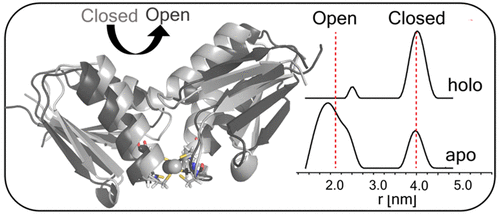当前位置:
X-MOL 学术
›
J. Phys. Chem. B
›
论文详情
Our official English website, www.x-mol.net, welcomes your
feedback! (Note: you will need to create a separate account there.)
Cu(I) Controls Conformational States in Human Atox1 Metallochaperone: An EPR and Multiscale Simulation Study.
The Journal of Physical Chemistry B ( IF 2.8 ) Pub Date : 2020-05-12 , DOI: 10.1021/acs.jpcb.0c01744
Ortal Perkal 1 , Zena Qasem 2 , Meital Turgeman 2 , Renana Schwartz 1 , Lada Gevorkyan-Airapetov 2 , Matic Pavlin 3 , Alessandra Magistrato 3 , Dan Thomas Major 1 , Sharon Ruthstein 2
The Journal of Physical Chemistry B ( IF 2.8 ) Pub Date : 2020-05-12 , DOI: 10.1021/acs.jpcb.0c01744
Ortal Perkal 1 , Zena Qasem 2 , Meital Turgeman 2 , Renana Schwartz 1 , Lada Gevorkyan-Airapetov 2 , Matic Pavlin 3 , Alessandra Magistrato 3 , Dan Thomas Major 1 , Sharon Ruthstein 2
Affiliation

|
Atox1 is a human copper metallochaperone that is responsible for transferring copper ions from the main human copper transporter, hCtr1, to ATP7A/B in the Golgi apparatus. Atox1 interacts with the Ctr1 C-terminal domain as a dimer, although it transfers the copper ions to ATP7A/B in a monomeric form. The copper binding site in the Atox1 dimer involves Cys12 and Cys15, while Lys60 was also suggested to play a role in the copper binding. We recently showed that Atox1 can adopt various conformational states, depending on the interacting protein. In the current study, we apply EPR experiments together with hybrid quantum mechanics–molecular mechanics molecular dynamics simulations using a recently developed semiempirical density functional theory approach, to better understand the effect of Atox1’s conformational states on copper coordination. We propose that the flexibility of Atox1 occurs owing to protonation of one or more of the cysteine residues, and that Cys15 is an important residue for Atox1 dimerization, while Cys12 is a critical residue for Cu(I) binding. We also show that Lys60 electrostatically stabilizes the Cu(I)–Atox1 dimer.
中文翻译:

Cu(I) 控制人类 Atox1 金属伴侣的构象状态:EPR 和多尺度模拟研究。
Atox1 是一种人类铜金属伴侣,负责将铜离子从主要的人类铜转运蛋白 hCtr1 转移到高尔基体中的 ATP7A/B。Atox1 作为二聚体与 Ctr1 C 末端结构域相互作用,尽管它以单体形式将铜离子转移到 ATP7A/B。Atox1 二聚体中的铜结合位点涉及 Cys12 和 Cys15,而 Lys60 也被认为在铜结合中起作用。我们最近表明 Atox1 可以采用各种构象状态,这取决于相互作用的蛋白质。在目前的研究中,我们使用最近开发的半经验密度泛函理论方法将 EPR 实验与混合量子力学-分子力学分子动力学模拟一起应用,以更好地了解 Atox1 的构象状态对铜配位的影响。我们提出 Atox1 的灵活性是由于一个或多个半胱氨酸残基的质子化而发生的,并且 Cys15 是 Atox1 二聚化的重要残基,而 Cys12 是 Cu(I) 结合的关键残基。我们还表明 Lys60 静电稳定了 Cu(I)-Atox1 二聚体。
更新日期:2020-05-12
中文翻译:

Cu(I) 控制人类 Atox1 金属伴侣的构象状态:EPR 和多尺度模拟研究。
Atox1 是一种人类铜金属伴侣,负责将铜离子从主要的人类铜转运蛋白 hCtr1 转移到高尔基体中的 ATP7A/B。Atox1 作为二聚体与 Ctr1 C 末端结构域相互作用,尽管它以单体形式将铜离子转移到 ATP7A/B。Atox1 二聚体中的铜结合位点涉及 Cys12 和 Cys15,而 Lys60 也被认为在铜结合中起作用。我们最近表明 Atox1 可以采用各种构象状态,这取决于相互作用的蛋白质。在目前的研究中,我们使用最近开发的半经验密度泛函理论方法将 EPR 实验与混合量子力学-分子力学分子动力学模拟一起应用,以更好地了解 Atox1 的构象状态对铜配位的影响。我们提出 Atox1 的灵活性是由于一个或多个半胱氨酸残基的质子化而发生的,并且 Cys15 是 Atox1 二聚化的重要残基,而 Cys12 是 Cu(I) 结合的关键残基。我们还表明 Lys60 静电稳定了 Cu(I)-Atox1 二聚体。







































 京公网安备 11010802027423号
京公网安备 11010802027423号